Unit1 lesson4~6 复习课件 2024-2025学年仁爱科普版英语七年级上册
文档属性
| 名称 | Unit1 lesson4~6 复习课件 2024-2025学年仁爱科普版英语七年级上册 |  | |
| 格式 | pptx | ||
| 文件大小 | 15.7MB | ||
| 资源类型 | 试卷 | ||
| 版本资源 | 仁爱科普版 | ||
| 科目 | 英语 | ||
| 更新时间 | 2024-12-23 18:43:10 | ||
图片预览

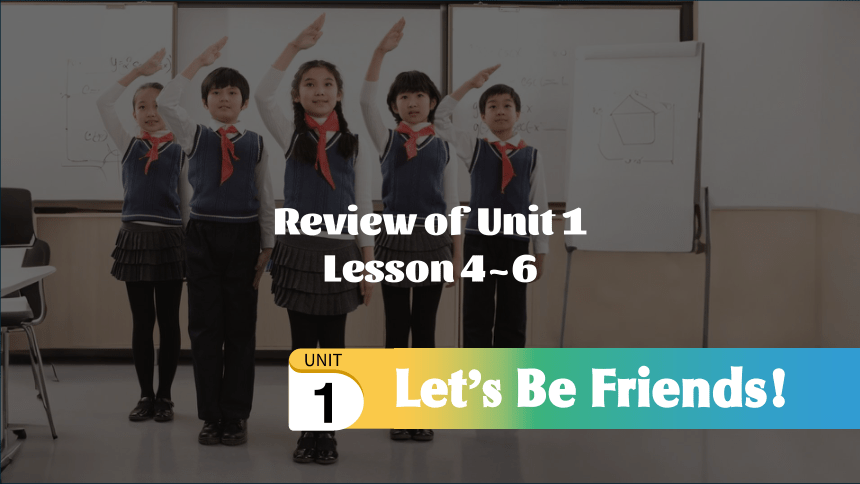
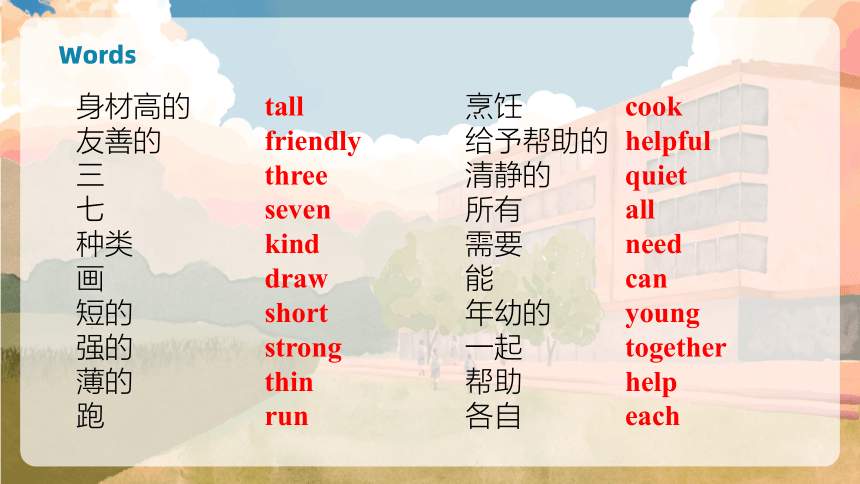
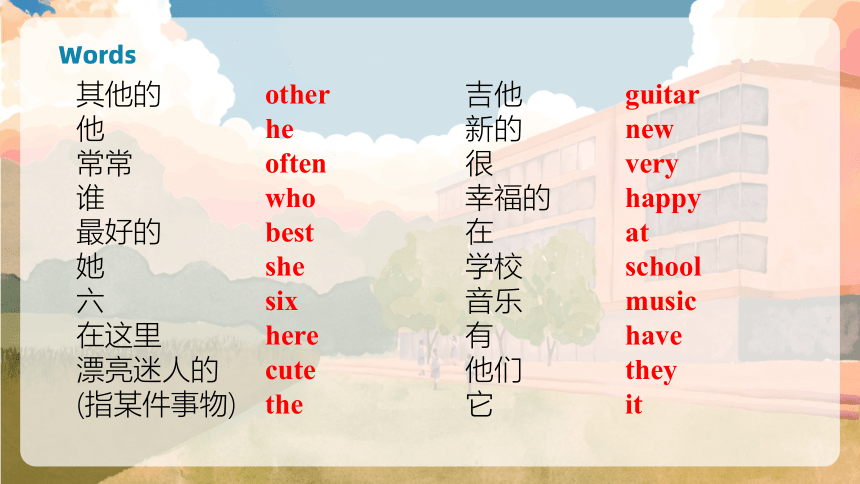
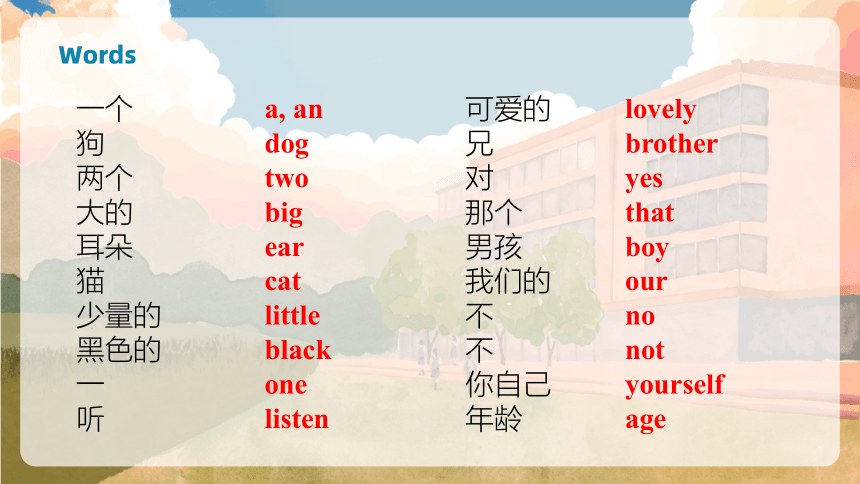
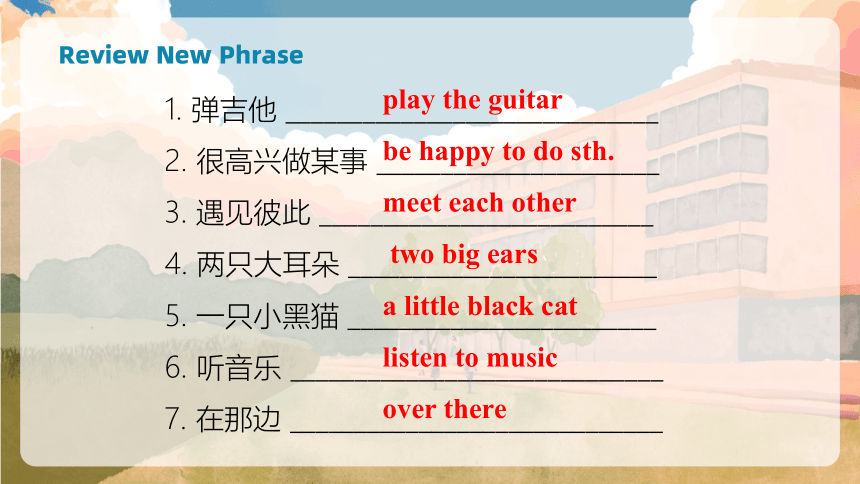
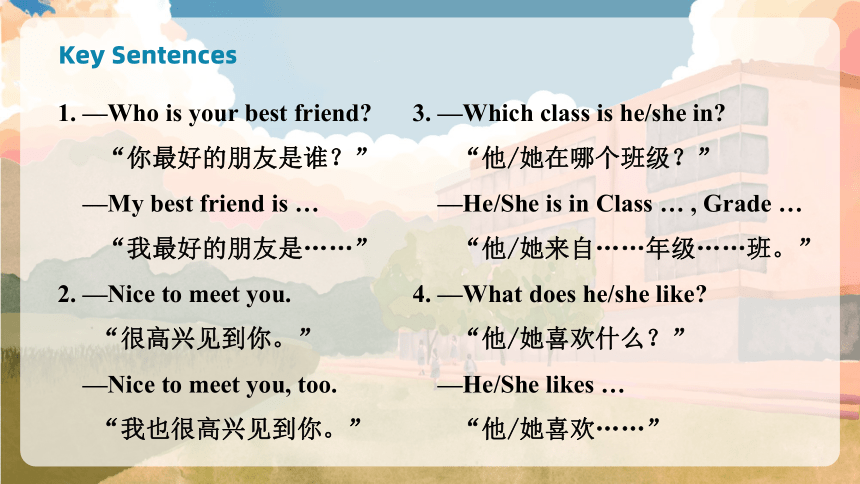
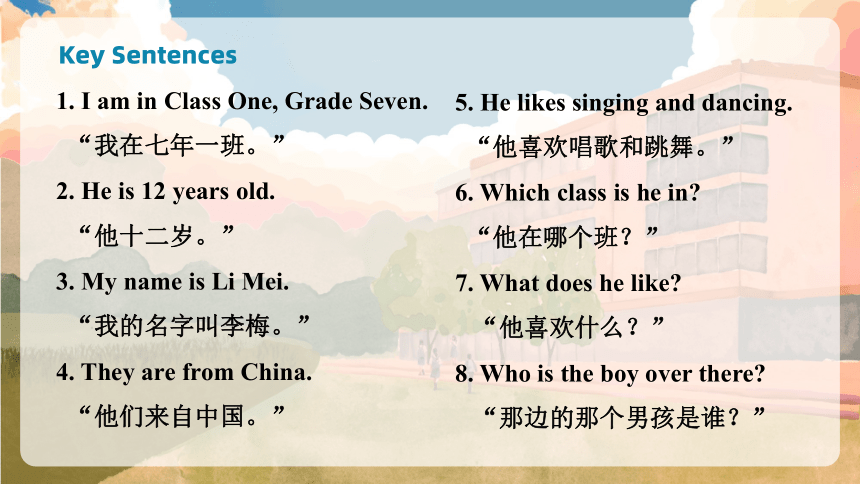
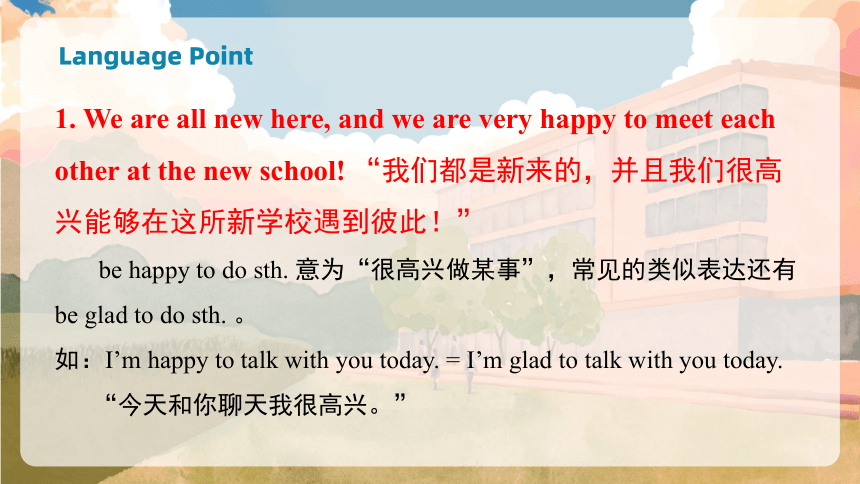
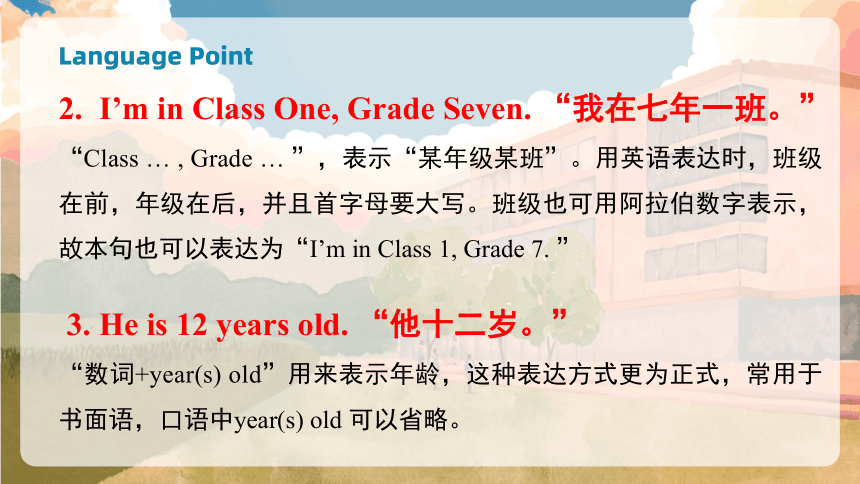
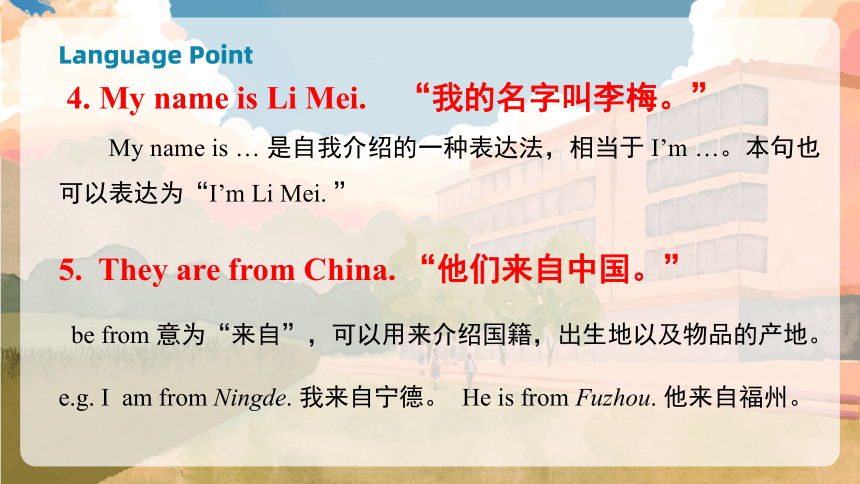
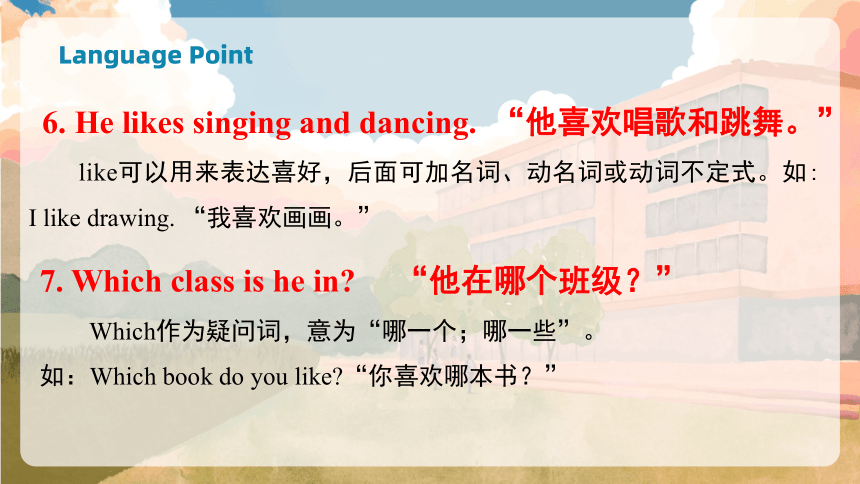
文档简介
(共32张PPT)
tall
friendly
three
seven
kind
draw
short
strong
thin
run
身材高的
友善的
三
七
种类
画
短的
强的
薄的
跑
cook
helpful
quiet
all
need
can
young
together
help
each
烹饪
给予帮助的
清静的
所有
需要
能
年幼的
一起
帮助
各自
other
he
often
who
best
she
six
here
cute
the
其他的
他
常常
谁
最好的
她
六
在这里
漂亮迷人的
(指某件事物)
guitar
new
very
happy
at
school
music
have
they
it
吉他
新的
很
幸福的
在
学校
音乐
有
他们
它
a, an
dog
two
big
ear
cat
little
black
one
listen
一个
狗
两个
大的
耳朵
猫
少量的
黑色的
一
听
lovely
brother
yes
that
boy
our
no
not
yourself
age
可爱的
兄
对
那个
男孩
我们的
不
不
你自己
年龄
1. 弹吉他 _____________________________
2. 很高兴做某事 ______________________
3. 遇见彼此 __________________________
4. 两只大耳朵 ________________________
5. 一只小黑猫 ________________________
6. 听音乐 _____________________________
7. 在那边 _____________________________
play the guitar
be happy to do sth.
meet each other
two big ears
a little black cat
listen to music
over there
1. —Who is your best friend
“你最好的朋友是谁?”
—My best friend is …
“我最好的朋友是……”
2. —Nice to meet you.
“很高兴见到你。”
—Nice to meet you, too.
“我也很高兴见到你。”
3. —Which class is he/she in
“他/她在哪个班级?”
—He/She is in Class … , Grade …
“他/她来自……年级……班。”
4. —What does he/she like
“他/她喜欢什么?”
—He/She likes …
“他/她喜欢……”
1. I am in Class One, Grade Seven.
“我在七年一班。”
2. He is 12 years old.
“他十二岁。”
3. My name is Li Mei.
“我的名字叫李梅。”
4. They are from China.
“他们来自中国。”
5. He likes singing and dancing.
“他喜欢唱歌和跳舞。”
6. Which class is he in
“他在哪个班?”
7. What does he like
“他喜欢什么?”
8. Who is the boy over there
“那边的那个男孩是谁?”
1. We are all new here, and we are very happy to meet each other at the new school! “我们都是新来的,并且我们很高兴能够在这所新学校遇到彼此!”
be happy to do sth. 意为“很高兴做某事”,常见的类似表达还有be glad to do sth. 。
如:I’m happy to talk with you today. = I’m glad to talk with you today.
“今天和你聊天我很高兴。”
2. I’m in Class One, Grade Seven. “我在七年一班。”
“Class … , Grade … ”,表示“某年级某班”。用英语表达时,班级在前,年级在后,并且首字母要大写。班级也可用阿拉伯数字表示,故本句也可以表达为“I’m in Class 1, Grade 7. ”
3. He is 12 years old. “他十二岁。”
“数词+year(s) old”用来表示年龄,这种表达方式更为正式,常用于书面语,口语中year(s) old 可以省略。
4. My name is Li Mei. “我的名字叫李梅。”
My name is … 是自我介绍的一种表达法,相当于 I’m …。本句也可以表达为“I’m Li Mei. ”
5. They are from China. “他们来自中国。”
be from 意为“来自”,可以用来介绍国籍,出生地以及物品的产地。
e.g. I am from Ningde. 我来自宁德。 He is from Fuzhou. 他来自福州。
6. He likes singing and dancing. “他喜欢唱歌和跳舞。”
like可以用来表达喜好,后面可加名词、动名词或动词不定式。如: I like drawing. “我喜欢画画。”
7. Which class is he in “他在哪个班级?”
Which作为疑问词,意为“哪一个;哪一些”。
如:Which book do you like “你喜欢哪本书?”
8.Here are my friends. 这是我的朋友们。
这是一个倒装句。当here、there在句首时,主语如果是名词,要用全部倒装的结构,即“Here/There+谓语动词/系动词+名词.”。谓语动词的单复数形式要与名词保持一致。
Here comes the bus. 公共汽车来了。
【拓展】主语如果是代词,主语和谓语的顺序不变,即“Here/There+代词+谓语动词/系动词.”。
Here we are. 我们到了。
9.She likes singing and playing the guitar.她喜欢唱歌和弹吉他。
在英语中,所有的西洋乐器前都要加冠词the;而在表达中国乐器的时候,可以不加冠词the。
play the piano 弹钢琴 play erhu拉二胡
【拓展】表示球类、棋类的名词前不加冠词。
play football踢足球 play chess下棋
10.Kangkang has three friends. 康康有三个朋友。
have作动词,在此处意为“有”。have作动词时,还可意为“吃;经历”。
I have breakfast at home. 我在家吃早饭。
I often have a good time with my friends. 我经常和朋友们玩得很开心。
11.What about you, Meimei?你呢,梅梅?
what/how about 用于提出建议、询问情况、征询意见等场合。
I like this film. What/How about you 我喜欢这部电影。你呢?
12.Who is the boy over there?那边的男孩是谁?
over there意为“在那边”,通常用于表示某个地点或事物在说话者的视线或感知范围内,但有一定的距离。
Look! My dog is over there. 看!我的狗在那边。
1. 特殊疑问词
特殊疑问词是特殊疑问句中必有(开头第一个)的单词,一般配合特殊疑问句使用。常见的特殊疑问词有what, where, when, who, whose, which, why, how。
特殊疑问词
疑问词 含义 提问对象 例句
what
where
when
什么
何地
何时
问东西
问地点
问时间
—What’s this —It’s a pen.
—Where is my mother
—She is in the room.
—When do you play
football
— In the afternoon.
特殊疑问词
疑问词 含义 提问对象 例句
who
whose
which
谁
谁的
哪一个
问人
问某人的东
西(所属)
问选择
—Who is that boy
—He is my brother.
—Whose book is it
—It’s Lucy’s.
Which flower is beautiful, the red one or
the blue one
特殊疑问词
疑问词 含义 提问对象 例句
why
how
为什么
怎么样
问原因
问方式、方法
—Why do you like art
—Because it is fun.
—How do you go to school
—On foot.
2. 人称代词主格
人称代词是直接指代人或物的代词。人称代词有人称、数和格的变化。人称代词主格在句中作主语。
人称 单数 复数
第一人称 I(我) we(我们)
第二人称 you(你) you(你们)
第三人称 he(他),she(她),it(它) they(他/她/它们)
I am tall and thin. 我又高又瘦。
You are nice. 你真好。
He is a helpful boy. 他是个乐于助人的男孩。
They often sing together. 他们经常一起唱歌。
【注意】在英语中,人称代词的排序遵循一定的规则,这些规则在单数和复数形式下有所不同。单数人称代词并列作主语时,其顺序为:第二人称(you)、第三人称(he/she/it)、第一人称(I)。复数人称代词作主语时,其顺序为:第一人称(we)、第二人称(you)、第三人称(they)。
You, he and I all like playing football. 你、他和我都喜欢踢足球。
We, you and they are all good students. 我们、你们和他们都是好学生。
3. 含有be动词的一般现在时
1.be动词的形式
be动词 用法
am 用于第一人称单数I后面
is 用于第三人称单数的代词或名词后面
are 用于第二人称you和复数代词或名词后面
2 .含有be动词的一般现在时的句式结构
句式 结构 例句
肯定句 主语+be+其他. I am from Beijing.我来自北京。
Jane is a good girl.简是个好女孩。
They are my friends.他们是我的朋友。
【注意】在肯定回答“Yes, it is.” “Yes, I am.”中,it is和I am不能缩写为it’s和I’m。
句式 结构 例句
否定句 主语+be+not+其他. I am not in Class 6.我不在6班。
一般疑问句 及其答语 -Be+主语+其他? -Yes,主语+be./ No,主语+be+not. -Is Tom your classmate?
汤姆是你的同班同学吗?
-Yes,he is./No,he isn’t.
是的,他是。/不,他不是。
4. 开/闭音节
(1)以一个元音字母结尾的重读音节,这个元音字母在单词中发它在字母表中的音,即它本身的读音,如:no / /, he /i:/。
(2)在含有一个元音字母的重读音节中,在元音字母后有一个辅音字母(r除外)与一个不发音的字母e,这个元音字母发它本身的音,如:name /e /, fine /a /。
(3)以一个或几个辅音字母(r除外)结尾而中间只有一个元音字母的音节,称为闭音节。如:map, desk,is。在重读的闭音节中元音字母读做短元音。
情景交际
1.你想知道Mary最好的朋友是谁, 可以这样问她:
______________________________________, Mary
2.你想知道John在哪个班级, 可以这样问老师:
____________________________________________
Who is your best friend
Which class is John in
根据语境填入正确的人称代词,每空一词。
Peter and I are friends. 1. ________ are very happy together at my home. My grandmother is at home, too. 2. ________ is 58. This is my brother Tim. 3. ________ is very tall. His pencil is red. 4. ________ is a gift(礼物) from his parents. These dogs are happy. 5. ________ are playing in the house.
We
She
It
He
They
( A )1.
C
A. cake B. take C. map D. wave
( A )2.
A
A. bread B. eat C. tea D. seat
( A )3.
D
A. never B. leg C. red D. he
( D )4.
D
A. bike B. five C. like D. his
( A )5.
C
A. go B. no C. to D. hello
找出下列画线部分发音不同的单词。
( A )1. —______ she Sally —Yes, she ______.
A. Is; isn’t B. Is; is C. Are; is
B
( A )2.—______ his telephone number 53817794
—No, it ______.
A. Is; isn’t B. Are; isn’t C. Are; aren’t
A
( A )3. —______ is your English teacher
—Mr. Hu.
A. Where B. What C. Who
C
( A)1. I ________ after I get up.
A. play with friends B. clean the room
C. have breakfast D. have lunch
B
( A)2. I’m not cleaning the room at ________.
A. 6:30 a.m. B. 7:30 a.m.
C. 8:30 a.m. D. 9:00 a.m.
A
( A)5. The passage is mainly about ________.
A. my friend B. my mom and I
C. my school D. my day
D
tall
friendly
three
seven
kind
draw
short
strong
thin
run
身材高的
友善的
三
七
种类
画
短的
强的
薄的
跑
cook
helpful
quiet
all
need
can
young
together
help
each
烹饪
给予帮助的
清静的
所有
需要
能
年幼的
一起
帮助
各自
other
he
often
who
best
she
six
here
cute
the
其他的
他
常常
谁
最好的
她
六
在这里
漂亮迷人的
(指某件事物)
guitar
new
very
happy
at
school
music
have
they
it
吉他
新的
很
幸福的
在
学校
音乐
有
他们
它
a, an
dog
two
big
ear
cat
little
black
one
listen
一个
狗
两个
大的
耳朵
猫
少量的
黑色的
一
听
lovely
brother
yes
that
boy
our
no
not
yourself
age
可爱的
兄
对
那个
男孩
我们的
不
不
你自己
年龄
1. 弹吉他 _____________________________
2. 很高兴做某事 ______________________
3. 遇见彼此 __________________________
4. 两只大耳朵 ________________________
5. 一只小黑猫 ________________________
6. 听音乐 _____________________________
7. 在那边 _____________________________
play the guitar
be happy to do sth.
meet each other
two big ears
a little black cat
listen to music
over there
1. —Who is your best friend
“你最好的朋友是谁?”
—My best friend is …
“我最好的朋友是……”
2. —Nice to meet you.
“很高兴见到你。”
—Nice to meet you, too.
“我也很高兴见到你。”
3. —Which class is he/she in
“他/她在哪个班级?”
—He/She is in Class … , Grade …
“他/她来自……年级……班。”
4. —What does he/she like
“他/她喜欢什么?”
—He/She likes …
“他/她喜欢……”
1. I am in Class One, Grade Seven.
“我在七年一班。”
2. He is 12 years old.
“他十二岁。”
3. My name is Li Mei.
“我的名字叫李梅。”
4. They are from China.
“他们来自中国。”
5. He likes singing and dancing.
“他喜欢唱歌和跳舞。”
6. Which class is he in
“他在哪个班?”
7. What does he like
“他喜欢什么?”
8. Who is the boy over there
“那边的那个男孩是谁?”
1. We are all new here, and we are very happy to meet each other at the new school! “我们都是新来的,并且我们很高兴能够在这所新学校遇到彼此!”
be happy to do sth. 意为“很高兴做某事”,常见的类似表达还有be glad to do sth. 。
如:I’m happy to talk with you today. = I’m glad to talk with you today.
“今天和你聊天我很高兴。”
2. I’m in Class One, Grade Seven. “我在七年一班。”
“Class … , Grade … ”,表示“某年级某班”。用英语表达时,班级在前,年级在后,并且首字母要大写。班级也可用阿拉伯数字表示,故本句也可以表达为“I’m in Class 1, Grade 7. ”
3. He is 12 years old. “他十二岁。”
“数词+year(s) old”用来表示年龄,这种表达方式更为正式,常用于书面语,口语中year(s) old 可以省略。
4. My name is Li Mei. “我的名字叫李梅。”
My name is … 是自我介绍的一种表达法,相当于 I’m …。本句也可以表达为“I’m Li Mei. ”
5. They are from China. “他们来自中国。”
be from 意为“来自”,可以用来介绍国籍,出生地以及物品的产地。
e.g. I am from Ningde. 我来自宁德。 He is from Fuzhou. 他来自福州。
6. He likes singing and dancing. “他喜欢唱歌和跳舞。”
like可以用来表达喜好,后面可加名词、动名词或动词不定式。如: I like drawing. “我喜欢画画。”
7. Which class is he in “他在哪个班级?”
Which作为疑问词,意为“哪一个;哪一些”。
如:Which book do you like “你喜欢哪本书?”
8.Here are my friends. 这是我的朋友们。
这是一个倒装句。当here、there在句首时,主语如果是名词,要用全部倒装的结构,即“Here/There+谓语动词/系动词+名词.”。谓语动词的单复数形式要与名词保持一致。
Here comes the bus. 公共汽车来了。
【拓展】主语如果是代词,主语和谓语的顺序不变,即“Here/There+代词+谓语动词/系动词.”。
Here we are. 我们到了。
9.She likes singing and playing the guitar.她喜欢唱歌和弹吉他。
在英语中,所有的西洋乐器前都要加冠词the;而在表达中国乐器的时候,可以不加冠词the。
play the piano 弹钢琴 play erhu拉二胡
【拓展】表示球类、棋类的名词前不加冠词。
play football踢足球 play chess下棋
10.Kangkang has three friends. 康康有三个朋友。
have作动词,在此处意为“有”。have作动词时,还可意为“吃;经历”。
I have breakfast at home. 我在家吃早饭。
I often have a good time with my friends. 我经常和朋友们玩得很开心。
11.What about you, Meimei?你呢,梅梅?
what/how about 用于提出建议、询问情况、征询意见等场合。
I like this film. What/How about you 我喜欢这部电影。你呢?
12.Who is the boy over there?那边的男孩是谁?
over there意为“在那边”,通常用于表示某个地点或事物在说话者的视线或感知范围内,但有一定的距离。
Look! My dog is over there. 看!我的狗在那边。
1. 特殊疑问词
特殊疑问词是特殊疑问句中必有(开头第一个)的单词,一般配合特殊疑问句使用。常见的特殊疑问词有what, where, when, who, whose, which, why, how。
特殊疑问词
疑问词 含义 提问对象 例句
what
where
when
什么
何地
何时
问东西
问地点
问时间
—What’s this —It’s a pen.
—Where is my mother
—She is in the room.
—When do you play
football
— In the afternoon.
特殊疑问词
疑问词 含义 提问对象 例句
who
whose
which
谁
谁的
哪一个
问人
问某人的东
西(所属)
问选择
—Who is that boy
—He is my brother.
—Whose book is it
—It’s Lucy’s.
Which flower is beautiful, the red one or
the blue one
特殊疑问词
疑问词 含义 提问对象 例句
why
how
为什么
怎么样
问原因
问方式、方法
—Why do you like art
—Because it is fun.
—How do you go to school
—On foot.
2. 人称代词主格
人称代词是直接指代人或物的代词。人称代词有人称、数和格的变化。人称代词主格在句中作主语。
人称 单数 复数
第一人称 I(我) we(我们)
第二人称 you(你) you(你们)
第三人称 he(他),she(她),it(它) they(他/她/它们)
I am tall and thin. 我又高又瘦。
You are nice. 你真好。
He is a helpful boy. 他是个乐于助人的男孩。
They often sing together. 他们经常一起唱歌。
【注意】在英语中,人称代词的排序遵循一定的规则,这些规则在单数和复数形式下有所不同。单数人称代词并列作主语时,其顺序为:第二人称(you)、第三人称(he/she/it)、第一人称(I)。复数人称代词作主语时,其顺序为:第一人称(we)、第二人称(you)、第三人称(they)。
You, he and I all like playing football. 你、他和我都喜欢踢足球。
We, you and they are all good students. 我们、你们和他们都是好学生。
3. 含有be动词的一般现在时
1.be动词的形式
be动词 用法
am 用于第一人称单数I后面
is 用于第三人称单数的代词或名词后面
are 用于第二人称you和复数代词或名词后面
2 .含有be动词的一般现在时的句式结构
句式 结构 例句
肯定句 主语+be+其他. I am from Beijing.我来自北京。
Jane is a good girl.简是个好女孩。
They are my friends.他们是我的朋友。
【注意】在肯定回答“Yes, it is.” “Yes, I am.”中,it is和I am不能缩写为it’s和I’m。
句式 结构 例句
否定句 主语+be+not+其他. I am not in Class 6.我不在6班。
一般疑问句 及其答语 -Be+主语+其他? -Yes,主语+be./ No,主语+be+not. -Is Tom your classmate?
汤姆是你的同班同学吗?
-Yes,he is./No,he isn’t.
是的,他是。/不,他不是。
4. 开/闭音节
(1)以一个元音字母结尾的重读音节,这个元音字母在单词中发它在字母表中的音,即它本身的读音,如:no / /, he /i:/。
(2)在含有一个元音字母的重读音节中,在元音字母后有一个辅音字母(r除外)与一个不发音的字母e,这个元音字母发它本身的音,如:name /e /, fine /a /。
(3)以一个或几个辅音字母(r除外)结尾而中间只有一个元音字母的音节,称为闭音节。如:map, desk,is。在重读的闭音节中元音字母读做短元音。
情景交际
1.你想知道Mary最好的朋友是谁, 可以这样问她:
______________________________________, Mary
2.你想知道John在哪个班级, 可以这样问老师:
____________________________________________
Who is your best friend
Which class is John in
根据语境填入正确的人称代词,每空一词。
Peter and I are friends. 1. ________ are very happy together at my home. My grandmother is at home, too. 2. ________ is 58. This is my brother Tim. 3. ________ is very tall. His pencil is red. 4. ________ is a gift(礼物) from his parents. These dogs are happy. 5. ________ are playing in the house.
We
She
It
He
They
( A )1.
C
A. cake B. take C. map D. wave
( A )2.
A
A. bread B. eat C. tea D. seat
( A )3.
D
A. never B. leg C. red D. he
( D )4.
D
A. bike B. five C. like D. his
( A )5.
C
A. go B. no C. to D. hello
找出下列画线部分发音不同的单词。
( A )1. —______ she Sally —Yes, she ______.
A. Is; isn’t B. Is; is C. Are; is
B
( A )2.—______ his telephone number 53817794
—No, it ______.
A. Is; isn’t B. Are; isn’t C. Are; aren’t
A
( A )3. —______ is your English teacher
—Mr. Hu.
A. Where B. What C. Who
C
( A)1. I ________ after I get up.
A. play with friends B. clean the room
C. have breakfast D. have lunch
B
( A)2. I’m not cleaning the room at ________.
A. 6:30 a.m. B. 7:30 a.m.
C. 8:30 a.m. D. 9:00 a.m.
A
( A)5. The passage is mainly about ________.
A. my friend B. my mom and I
C. my school D. my day
D
同课章节目录
